Beverly Gray's Blog: Beverly in Movieland, page 14
June 11, 2024
Taking a Stab at “Hit Man”
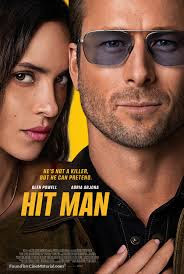
As a teacher of screenwritingthrough UCLA Extension’s The Writers’ Program, I’m always interested in what genresaspiring writers choose to concentrate on. I love the variety: romanticcomedies, action adventure, heartfelt dramas, police procedurals, family fare.For a while, a good proportion of my advanced screenwriting students seemed towant to focus on the physical and moral perils of being a hit man. To each his(or her) own, I guess. But the key maxim for writers has always been Write WhatYou Know. I suspect (phew!) that none of my students has put in time as amurderer for hire. That’s why these scripts, exciting though they may be, neverseem to have the ring of reality.
Which made me doubly curiousabout a new film, released through Netflix but currently in theatres, that’sbeen getting rave reviews. Hit Man, directed by Richard Linklater from ascript he co-wrote with the film’s star, Glen Powell, is based on a TexasMonthly article about a certain Gary Johnson. The late Johnson was a mild-mannered collegeinstructor, specializing in psychology and philosophy, who took on a part-timejob posing as a hit man. His employer was the local police department: his goalwas to ferret out citizens angry enough to pay a stranger to commit murder,after which they’d quickly be arrested and sent off to prison. Like hisreal-life counterpart, the film’s Gary Johnson discovers he thrives on donningdisguises and dancing around the edges of actual mayhem. But, as the closingcredits make clear, the actual Gary Johnson never broke the law. His screencounterpart, though, is a more complicated creature.
It all starts when he meets Maddy (thegorgeous Adria Arjona) who wants to get rid of her abusive ex by any meansnecessary. She accepts the killer-for-hire she meets at face value: he’s sexy tough-guy Ron. He knows,though, that underneath it all he’s meek and mild Gary, who’s quite capable offalling for Maddy, and doesn’t want to see her under arrest. When thisirresistible force and this immovable object get together, sparks fly . . . andthe audience thoroughly enjoys seeing where they go from here. No, of course Ihave no plans to give away the ending.
I knew Richard Linklater’swork from back in the Nineties, when he introduced Matthew McConaughey to theworld in Dazed and Confused. Inthis century, he’s made successful studio films like School of Rock and BadNews Bears, while also experimenting with a romantic indie trilogy abouttwo young people in Paris that started with Before Sunrise. To date, hisbravest experiment has been with 2014’s Boyhood, an Oscar-nominatedcoming-of-age drama that was filmed between 2002 and 2013, allowing the mainactors to grow and change over time. (Patricia Arquette won the statuette forBest Supporting Actress.) Now, however, he’s committed to filming StephenSondheim’s Merrily We Roll Along, a musical theatre piece which covers atwo-decade period in reverse chronology: he started filming in 2019 (with BenPlatt and Beany Feldstein in central roles) and—despite some key cast changesthat have required major reshoots—plans to devote twenty years to the project. Goodluck with that!
Prior to Hit Man, Ihad never heard of Glen Powell. Now I know he has a long track record in TV, aswell as recent successes in screen romantic comedies like Anyone But You.His breakout film role was as Lt. Jake "Hangman" Seresin in TopGun: Maverick. Don’t blame me if all the flyboys in that film blur togetherin my mind.
June 7, 2024
Murder, She Watched

Though I’ve always been a fanof the late, great Angela Lansbury, until recently I had never seen a singleepisode of the famous crime series in which she starred for twelve seasons, Murder,She Wrote. This CBS series, which ran from 1984 through 1996, starredLansbury as Jessica Fletcher, a novelist and amateur detective. She’s a retiredEnglish teacher comfortably ensconced in the quaint (and fictional) Maine townof Cabot Cove. A widow, she has taken up the writing of mystery novels inretirement, acquiring both fame and fortune. It’s all a bit of an echo ofAgatha Christie’s celebrated spinster sleuth, Miss Jane Marple, a shrewdamateur keen on solving mysterious deaths in and around her English village ofSt. Mary Mead. I’ve heard that Jessica Fletcher’s sleuthing and that of MissMarple fit into a sub-genre of crime fiction called “the cozies,” in which sexand violence are played down, the guilty have a tendency to eventually confesstheir misdeeds, and average citizens often turn out to be much smarter than the local constabulary. One withas noted that in a cozy series, the main character becomes embroiled in somany high-profile murders, often by accident, that the public may tend to getsuspicious. Citron Christian quips, in something called The Blot, thatJessica Fletcher had to be the actual murderer in every case, because"No matter where she goes, somebody dies!"
I got first-hand experienceof Murder, She Wrote over the past weekend, while spending the night ina resort town. Some obscure cable channel was having a marathon, and so Iwatched three episodes in a row. As it happened, they all aired in late 1985 orearly 1986, when star Lansbury was a spry sixty-year-old. (She is seen cruisingaround Cabot Cove on a bicycle in the opening credits.) The episode called“Murder Digs Deep” has her investigating a mysterious death while on anarchaeological jaunt in Mexico. “Murder by Appointment Only” takes her to NYC,where a lost lipstick becomes a key cluein a story set in the beauty industry. Frankly, they didn’t do much for me. (Tobe honest, it had been a long day and I kept dozing off.) But “Trial by Error”delighted me, because it puts the unflappable Jessica in a jury room, where assembledjurors must decide whether a man is guilty of involving his wife in anear-fatal auto accident.
I gather that part of the funof Murder, She Wrote is the appearance of guest stars with longhistories in the entertainment industry. In this episode, among the members of thejury are amiable Virginia Capers (The Fresh Prince of Bel-Air), cranky Tom Ewell (who starred opposite MarilynMonroe in The Seven Year Itch), ageing cutie-pie Arlene Golonka (TheAndy Griffith Show), the glowering Brock Peters (To Kill a Mockingbird),and the fawning Vicki Lawrence (Carol Burnett’s perennial sidekick). Naturally,in an obvious echo of the great jury-room drama, Twelve Angry Men, theydisagree from the start, with some jurors feeling the driver is obviouslyinnocent and others convinced that he’s obviously guilty. They agree on onlyone thing: that they want to finish up quickly and go home. But the sensibleJessica, who of course is selected as jury foreman, insists on examining eachbit of testimony, leading to a surprising set of conclusions. You see, it turnsout that there’s not just one murderer around: there are two. Though in TwelveAngry Men a careful look at the evidence finds an “obviously guilty” maninnocent, in Jessica Fletcher’s world there are murderers galore.
June 4, 2024
From Page to Screen: Launching ‘Oppenheimer”

Lucky me! Just a few monthsafter Oppenheimer picked up seven Oscars—including Best Picture—at theAcademy Awards ceremony, I heard Kai Bird explain in depth how it all came tobe. Bird, who donned a tux to attend the flashy ceremony at Hollywood’s DolbyTheatre, is the co-author of American Prometheus: The Triumph and Tragedy ofJ. Robert Oppenheimer. This massive 2005 biography of the theoreticalphysicist who during World Wart II led the Manhattan Project, resulting in theworld’s first atomic weapons, became the source material for Christopher Nolan’sblockbuster film. (The research leading to the completed book was begun byBird’s friend and co-author Martin J. Sherwin, an historian who passed away in2021.)
Though Bird and Sherwin wonthe Pulitzer Prize and other major honors for their 721-page opus, the motionpicture industry didn’t immediately get on board. Like most Hollywood stories, this one took itstime in moving from page to screen. That was one big takeaway from this year’s14th annual Biographers International Organization, a New Yorkgathering of old pros and biography newbies all of whom love the idea ofaccurately and compellingly putting a life into words. The session at which Birdappeared was titled “From Book to Film: Selling Options, Scripting, Producing.”The speakers, in addition to Bird, were biographers A’lelia Bundles and JackEl-Hai, both of whom had their own Hollywood stories to tell.
Needless to say, cynicismabounded at this gathering. Someone called up an old Hemingway story about how,when you sell your work to Hollywood, you stand at the California state lineand toss in a bag containing your magnum opus. In exchange, the Hollywoodmoguls toss back to you a sack full of money. Today the writer/producer dynamicis much more complicated, though, and the money is generally less. Happily,sometimes things work out.
Longtime journalist JackEl-Hai has had two biographical works optioned by Hollywood. The Lobotomist,his in-depth story of the doctor who invented the questionable procedure, hasnever quite made it to the screen. But The Nazi and the Psychiatrist –afterseveral false starts—was recently filmed in Europe with a cast headed byRussell Crowe and Rami Malek. Having watched the filming in progress, Jack is thrilledthat the project, now titled Nuremberg, will be out by the end of thisyear. Meanwhile, A’Lelia Bundles’ award-winning work on the life of her owngreat-great-grandmother, Black cosmetics and hair care entrepreneur Madam C.J.Walker, was transformed into Self-Made, a Netflix miniseries starringOctavia Spencer. Bundles has high praise for Spencer, but not for the execs whogarbled the true story of her ancestor, adding cat fights and other materialshe deemed offensive but was powerless to reject. (Her contract gave her scriptreview, not script approval, a very big difference.)
As for Oppenheimer, thematerial was originally optioned by Sam Mendes. He was coming off his Oscarwins for American Beauty, but couldn’t land the financing he needed.Several additional options followed: one produced a script filled with 108different historical inaccuracies, like Oppy maliciously poisoning rivalphysicist Edward Teller at a cocktail party, leading to a dramatic (but whollybogus) death scene. At long last, a billionaire with a physics background cameaboard, then approached Nolan, who cranked out a brilliant 200 -page scriptretaining virtually all the complexity of Bird’s and Sherwin’s scholarly study.When Bird pointed out a few small issues involving historical accuracy, hiswords were respected and corrections made. That’s why Bird calls himself today“the luckiest biographer in the history of the planet.”
May 31, 2024
Brothers (Somewhat) Grim: The Shermans and “Better Call Saul”
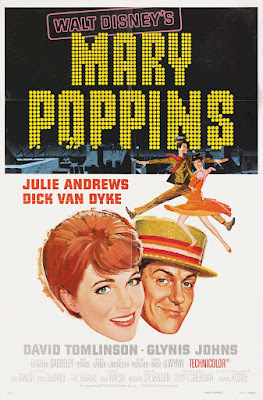 The passing of songwriterRichard Sherman at age 95 marks the end of an era of Disney-style songwriting.Along with older brother Robert, who died in 2012, Richard was on staff atDisney starting around 1960, working in the early years directly with Walthimself. The 2013 film Saving Mr. Banks, about the filming of MaryPoppins, charmingly illustrates the cozy relationship between Disney andthe two brothers (portrayed by Jason Schwartzman and B.J. Novak) he liked tocall “the boys.”
The passing of songwriterRichard Sherman at age 95 marks the end of an era of Disney-style songwriting.Along with older brother Robert, who died in 2012, Richard was on staff atDisney starting around 1960, working in the early years directly with Walthimself. The 2013 film Saving Mr. Banks, about the filming of MaryPoppins, charmingly illustrates the cozy relationship between Disney andthe two brothers (portrayed by Jason Schwartzman and B.J. Novak) he liked tocall “the boys.”As key players in the makingof Mary Poppins, the Shermans gave the world such jolly tunes as “ASpoonful of Sugar,” “Step in Time,” and "Supercalifragilisticexpialidocious,” winning one oftheir multiple Oscars for “Chim Chim Cher-ee." They were alsoresponsible for Walt’s own favorite, the tender ballad, “Feed the Birds.” Inaddition they wrote ditties for scores of other Disney movies, while alsocontributing to the soundtrack of the Disney theme parks such internationalearworms as “It’s A Small World (After All).” Personally, I don’t think I’llever forget the perky theme song for Tomorrowland’s long-defunct Carousel ofProgress (“There’s a bright new beautiful tomorrow/ Shining at the end of everyday”). Talk about optimism!
Though at work Richard andRobert Sherman were an unbeatable team, they were not always the best offriends in their private lives. According to Richard, there was never anyserious falling out between the two, but their personalities were such (Richardwas a life-of-the-party type, while his brother would rather read a book) thatthey didn’t mesh well on social occasions. That’s why they stayed clear of oneanother when not working, to the point that in later years Robert took upresidence in England, while Richard stayed put in SoCal. That fact shouldn’tentirely surprise us. Take a look at, for instance, the Bible, where it’s rareto come upon a pair of brothers whose relationship reflects true “brotherly”love. Or check out the very different men sired by the same father inDostoevsky’s masterwork, The Brothers Karamazov.
In movieland, there’s a highlysimilar dynamic. I could come up with many examples, but let’s start with thefilm adaptation of John Steinbeck’s 1952 novel East of Eden, in whichbrothers Cal and Aron (deliberately reflecting the tension between Cain andAbel in the Book of Genesis) vie—with disastrous results—for their father’sapprobation and the love of the same girl.
I’ve been thinking aboutpairs of brothers a lot lately, because (as a latecomer to the joys of cabletelevision) I’m deep into season three of Better Call Saul, the complexlead-up to Breaking Bad. In Better Call Saul, we see theevolution of the shady lawyer Saul Goodman (played by Bob Odenkirk) from hisbeginnings as Jimmy McGill, a natural grifter from Chicago who ends up(following a law school education via correspondence course through theUniversity of Western Samoa) as an attorney in Albuquerque, New Mexico. Jimmyis smart enough to be successful, but his every move turns out to be blocked byhis older brother Chuck (Michael McKean), a once-distinguished barrister withsevere psychological issues and a longstanding envy of Jimmy’s naturalcharisma. Jimmy loves and admires Chuck, in his way, but will never allow Chuckto bring him down. Chuck, we sense, hasalways hated his kid brother, ever since he figured out that Jimmy was theirmother’s favorite.
(Yup, it sounds like a much more seriousversion of the Smothers Brothers, another filial pair we’re in process oflosing. Tommy Smothers—whose signature line was “Mom always liked youbest!”—died on December 26, 2023.)
Brothers (Somewhat) Grim: The Shermans and “Breaking Bad”
 The passing of songwriterRichard Sherman at age 95 marks the end of an era of Disney-style songwriting.Along with older brother Robert, who died in 2012, Richard was on staff atDisney starting around 1960, working in the early years directly with Walthimself. The 2013 film Saving Mr. Banks, about the filming of MaryPoppins, charmingly illustrates the cozy relationship between Disney andthe two brothers (portrayed by Jason Schwartzman and B.J. Novak) he liked tocall “the boys.”
The passing of songwriterRichard Sherman at age 95 marks the end of an era of Disney-style songwriting.Along with older brother Robert, who died in 2012, Richard was on staff atDisney starting around 1960, working in the early years directly with Walthimself. The 2013 film Saving Mr. Banks, about the filming of MaryPoppins, charmingly illustrates the cozy relationship between Disney andthe two brothers (portrayed by Jason Schwartzman and B.J. Novak) he liked tocall “the boys.”As key players in the makingof Mary Poppins, the Shermans gave the world such jolly tunes as “ASpoonful of Sugar,” “Step in Time,” and "Supercalifragilisticexpialidocious,” winning one oftheir multiple Oscars for “Chim Chim Cher-ee." They were alsoresponsible for Walt’s own favorite, the tender ballad, “Feed the Birds.” Inaddition they wrote ditties for scores of other Disney movies, while alsocontributing to the soundtrack of the Disney theme parks such internationalearworms as “It’s A Small World (After All).” Personally, I don’t think I’llever forget the perky theme song for Tomorrowland’s long-defunct Carousel ofProgress (“There’s a bright new beautiful tomorrow/ Shining at the end of everyday”). Talk about optimism!
Though at work Richard andRobert Sherman were an unbeatable team, they were not always the best offriends in their private lives. According to Richard, there was never anyserious falling out between the two, but their personalities were such (Richardwas a life-of-the-party type, while his brother would rather read a book) thatthey didn’t mesh well on social occasions. That’s why they stayed clear of oneanother when not working, to the point that in later years Robert took upresidence in England, while Richard stayed put in SoCal. That fact shouldn’tentirely surprise us. Take a look at, for instance, the Bible, where it’s rareto come upon a pair of brothers whose relationship reflects true “brotherly”love. Or check out the very different men sired by the same father inDostoevsky’s masterwork, The Brothers Karamazov.
In movieland, there’s a highlysimilar dynamic. I could come up with many examples, but let’s start with thefilm adaptation of John Steinbeck’s 1952 novel East of Eden, in whichbrothers Cal and Aron (deliberately reflecting the tension between Cain andAbel in the Book of Genesis) vie—with disastrous results—for their father’sapprobation and the love of the same girl.
I’ve been thinking aboutpairs of brothers a lot lately, because (as a latecomer to the joys of cabletelevision) I’m deep into season three of Better Call Saul, the complexlead-up to Breaking Bad. In Better Call Saul, we see theevolution of the shady lawyer Saul Goodman (played by Bob Odenkirk) from hisbeginnings as Jimmy McGill, a natural grifter from Chicago who ends up(following a law school education via correspondence course through theUniversity of Western Samoa) as an attorney in Albuquerque, New Mexico. Jimmyis smart enough to be successful, but his every move turns out to be blocked byhis older brother Chuck (Michael McKean), a once-distinguished barrister withsevere psychological issues and a longstanding envy of Jimmy’s naturalcharisma. Jimmy loves and admires Chuck, in his way, but will never allow Chuckto bring him down. Chuck, we sense, hasalways hated his kid brother, ever since he figured out that Jimmy was theirmother’s favorite.
(Yup, it sounds like a much more seriousversion of the Smothers Brothers, another filial pair we’re in process oflosing. Tommy Smothers—whose signature line was “Mom always liked youbest!”—died on December 26, 2023.)
May 28, 2024
Movies as the Splice of Life

Charles Jensen’s Splice ofLife is not the first book I’ve ever read that tells a personal story byway of the films that have shaped the author’s life. I remember with affectionJohn Manderino’s Crying at Movies. In that charming book Manderinoadmits learning how to kiss through watching the Swedish art film ElviraMadigan, and divulges that his apparent physical resemblance to The Graduate’s“rodent-like” Dustin Hoffman won him an unexpected bed partner. But Jensen’s newwork, subtitled “A Memoir in 13 Film Genres,” is both the smartest and the mostcomplex example of the genre that I’ve ever encountered.
I know Charles Jensen as thehighly dedicated director of the Writers’ Program, offered both “on-ground” andonline through UCLA Extension. Before I read his new book, I was aware that heis a serious poet, as well as a man deeply committed to providing learningopportunities to students of every stripe. But Splice of Life has givenme new insight into the fellow who oversees the screenwriting classes I offertwice a year. It’s a deeply personal look at Charlie’s in-depth fascinationwith movies, and how films intersect with the high and low points of his ownsometimes complicated life.
Theearly chapters detail Charlie’s awkward acknowledgment of his own sexualleanings by way of films like Mean Girls (which neatly parallels hishigh school years) and Fatal Attraction. I love his smart close readingof the latter film, in which he views not the sexy seductress Alex (GlennClose) but the philandering husband Dan (Michael Douglas) as the villain of thepiece. His take on Fatal Attraction led me to think hard about how the“victim” label in movies is sometimes used to excuse what he calls “peak malefuckery.” He has also taught me a new key term—“queer coding”—that indicateshow (in popular films like Scream) gay subtext is partially concealed,except for those with eyes to see.
Oneof my favorite chapters goes back to classic Hitchcock: 1943’s Shadow of aDoubt. Charlie’s analysis of thisgreat film (in which the seemingly amiable Joseph Cotten secretly dispatcheswealthy widows) uncovers more “queer coding,” but it also plays against thestartling real-life story of a member of Charlie’s extended social circle, whowas ultimately convicted of murder.
As Charlie shows himselfevolving into a relatively happy and productive Angeleno (following the awkwardyears in the upper Midwest and the formative ones in Arizona), his film pairingssometimes become more lighthearted. He matches Get Him to the Greek withthe poignant but also rather wacky story of the burial of his grandmother’scremains. We also, in various chapters, learn about his hair-loss anxiety, hisbody-image issues (he deals here with the obsessive ballerina in Black Swan),and—somewhat climactically—his semi-successful appearance on Jeopardy! Tocapture the emotion of his big moment on the tube, he writes about the rawcompetition spelled out in The Hunger Games. It all leaves me wonderinghow the UCLA Writers’ Program will figure in his next book, and what film he’llchoose to illustrate the complexities of his current job.
Charlie opens Splice ofLife with three wonderful quotes from master filmmakers. I can’t resistquoting them here, because they all figure into what he’s achieved between hisbook’s covers:
Cinema is a mirror by whichwe often see ourselves. —Alejandro González Iñárritu
Anything that is notautobiography is plagiarism. —Pedro Almodóvar
A film is never really goodunless the camera is an eye in the head of a poet. —Orson Welles
Congratulations, Charlie!
May 24, 2024
A Helluva Town: How New York Takes Over
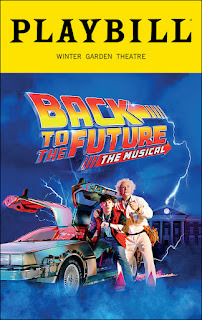
I’m just back from New YorkCity, the self-proclaimed capital of American culture. Though I love visiting,I have a bit of a grudge against the Big Apple, for the way that it scoops uptalents developed elsewhere. Film critic Justin Chang, an Angeleno with aSouthern California education, started honing his craft on Variety, andthen served with distinction as the #1 movie commentator at the Los AngelesTimes. His work on the Times has just won him this year’s PulitzerPrize for criticism, but by the time it was announced he had recently decampedfrom the Times to take a post at TheNew Yorker.
Chang’s eastward move matchesthat of other esteemed L.A. Times writers, like film reviewer ManohlaDargis, who became the chief critic of the New York Times and is afive-time Pulitzer finalist. In an adjacent field of criticism, Ruth Reichlspent nine years at the L.A. Times before moving to New York in 1993 asthe New York Times’ top restaurant reviewer. Today she is an esteemedfood writer, who stays busy publishing food-related memoirs, magazines, andcookbooks.
Then there’s the field ofmusic. As an Angeleno native, I remember the local dismay when Zubin Mehta, thebrilliant young conductor of the Los Angeles Philharmonic from 1962 to 1978,was suddenly announced as the new leader of the venerable New YorkPhilharmonic, a post he retained until 1991. Currently history seems to berepeating itself. It seemed like quite a novelty in 2007 when a talented butmostly unknown young Venezuelan named Gustavo Dudamel was announced as theupcoming leader of the L.A. Phil. The orchestra, under his enthusiasticdirection, was constantly making headlines and being welcomed into concerthalls the world over. Now, though, he’s looking forward to a five-year contractwith (yup!) the New York Phil, starting in 2026. What’s next for L.A.? I’mguessing another gifted no-name whom New York will eventually poach.
SoCal gets a bit of its ownback, I guess, when it comes to on-stage musical entertainment. There was atime, of course, when the big shows first appeared on Broadway (think WestSide Story, My Fair Lady, The Sound of Music, and Fiddler on theRoof), and were then transferred to the screen with much hoopla. Manypopular stage musicals became big Oscar winners, though the very last (ananomaly at the time) was the film version of Kander and Ebb’s Chicago in2002. In recent years the trend has beentotally reversed, with popular films trying to make it big as stage musicals,often with mediocre results. I remember Broadway introducing stage versions ofsuch hugely popular films as An American in Paris, Singin’ in theRain, and Seven Brides for Seven Brothers, in which the big takeawaywas that a Broadway actor can’t step into the shoes of a genuine movie star andexpect the same outpouring of affection from the audience.
Films that didn’tstart out as musicals may do slightly better: I recall watching on the TonyAwards broadcast a really imaginative number from a musicalized stage versionof Catch Me if You Can. And composer/lyricist Adam Guettel, the grandsonof Richard Rodgers, has made something of a career of adapting small, seriousfilms for the musical stage. His The Light in the Piazza won awards inthe early days of this century, and in 2023 Days of Wine and Roses garneredrespect, if not big box office. Alas, it closed on Broadway in March. One of myremaining choices was a musical translation of Back to the Future.
Dedicated to the membersof BIO, the Biographers International Organization, whose New York Cityconferences are always so enlightening and so much fun.
May 21, 2024
Unfrosted: Sixties Silliness
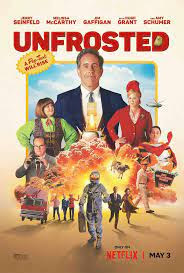
Netflix’s new Unfrosted,the directorial debut of Jerry Seinfeld, is rated PG-13. But you’d have to be a lot older than thirteento catch all the comic references (and would-be comic references) to the era inwhich this TV movie is set. In fact co-writer (as well as director and star) Seinfeldwas himself merely a kid in 1963 when JFK was president, NASA was prepping amoon mission, Walter Cronkite ruled the airwaves, and Kellogg’s was introducingits new breakfast idea, Pop Tarts.
I’m not quite sure whySeinfeld and his cronies decided the world needed a fictionalized version ofthe rivalry between Kellogg’s and Post, both of then Battle Creek, Michigancompanies striving to be numero uno in the American breakfast market.But they must have felt that the rampant consumerism of the era made for alively target. And so it does, at least for a while. In their version (whichhas nothing to do with actual fact), Post—led by Amy Schumer as MarjorieMerriweather Post—has stolen Kellogg’s plans for a heat-and-serve breakfastpastry, and is preparing for a huge roll-out of the new product. To head offthis effort, Kellogg’s team has cornered the market in Cuban sugar, andborrowed the shape of a Univac punch card to create their own pastry. They’vethen brought in Jon Hamm and John Slattery of Mad Men fame to give theirinvention the proper P.R. push, making Pop Tarts fly off store shelves, unlikePost’s almost identical Country Squares.
The film also finds room forMelissa McCarthy, Bob Gaffigan (as Edsel Kellogg III, the Seinfeld character’sboss), Dan Levy (in a brief appearance as Andy Warhol), and Peter Dinklage (leading the milkindustry’s charge against the new product). James Marsden, hamming it up as TVexercise king Jack Lalanne, heads a lively parade of the era’s commercialicons, which include Chef Boyardee and the maker of Schwinn bikes. And speaking of icons, none other than HughGrant plays Thurl Ravenscroft, an actor whose claim to fame is being thesonorous voice of Kellogg’s Tony the Tiger. Ravenscroft was an actual voiceperformer, much beloved by Disney animators, but in Seinfeld’s version he’s afrustrated Shakespearean actor who ends up leading a gaggle of cerealmascots--think Snap, Crackle, and Pop—in a work action against theirunappreciative bosses.
In an effort to leave noSixties celebrities unspoofed, Unfrosted also makes room for JohnnyCarson, John F. Kennedy (furnished with a Boston accent and a pair ofattractive blonde twins), and Nikita Khrushchev, who’s brought into theconflict by the Post folks. (Trying to woo him, they posit the introduction ofsome Russian-friendly cereals like Borscht Loops and Count Vodkula.) There’s also much would-be jocularitysurrounding NASA’s early stabs at space exploration. One joke involving thedeath in a 1967 launchpad fire of early astronaut Gus Grissom did not go overwell in my household.
With Jerry Seinfeld’s humorgetting more political these days, it wasn’t surprising to notice a morecurrent allusion too. At a point near the end of the film, when strikingmascots are demanding that governmental officials “stop the certification” ofthe new product, the rhetoric is an obvious spoof of the events of January 6,2021 (and Hugh Grant’s character appears in a Tiger-striped version of theso-called "QAnon Shaman" who wore an outlandish headdress to stormthe U.S. Capitol.) Clever parody? I’m not so sure. More like a cluster ofbuddies at a late-night bull session, thinking up everything and anything thatcould make them laugh.
May 16, 2024
No Stuntmen Were Harmed in the Making of this Movie?: “The Fall Guy”
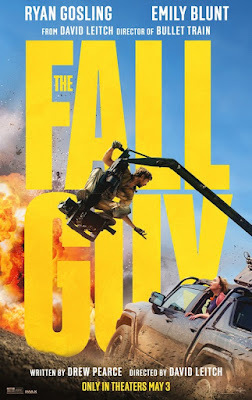
Back during my Roger Cormanyears, I went on location to help with the making of an Angie Dickinson flick,1974’s Big Bad Mama. Somewhat inspired by the success of Bonnie and Clyde,it’s about a mother/daughter Depression-era crime spree in the rural Southwest.As the story unfolds, a very game Angie gets up close and personal with bothWilliam Shatner and Tom Skerritt, and a good time is had by all.
Though most of my days were spentat my desk, I was very much present for the stunt team’s biggest moment on thatfilm. Set on a quaint local street in the then-sleepy town of Temecula, California,it involved a car chase that results in the dramatic flipping over of a vintage!930s-era auto. Of course we all wanted to see our stunt guy roll that car, andso New World Pictures personnel were present in force for the big moment. Witha stunt such as this one, you don’t get more than one chance to do it right.And so we all held our breaths when the big moment came. Fortunately, the moviegods smiled down, and it all went beautifully. And so the successful driverunbuckled his safety gear and sauntered off to the local bar.
I thought of that experiencewhile watching the new and delightful Ryan Gosling/Emily Blunt film, TheFall Guy. It certainly makes the case that there’s no business like showbusiness, and that stuntmen are a breed apart. I defy anyone to make sense ofthe plot of The Fall Guy. But why let a little thing like credibilitystand in the way of enjoying a wild and crazy story that includes every kind ofstunt you can think of, all of them taking place in and around beautiful Sydneyharbor?
The Fall Guy, loosely based on a TV series that ran from 1981 to1986, stars the ubiquitous Ryan Gosling as a stuntman named Colt Seavers, whosecareer threatens to be cut short by a serious miscue while he’s shooting a dramaticfall. Holing up to heal in solitude, he alienates his Own True Love, a would-bedirector named Jody, played with sass by Emily Blunt. But, while Colt is parkingcars to make ends meet, he gets a mysterious summons to take part in Jody’sdirectorial debut, a SFX-heavy space opera called Metalstorm. His job (match!)will be to double for star Tom Ryder, an arrogant macho-man type who likes topublicize the fact that he performs all his own stunts. (Yeah, right!)
Suffice it to say that thereare chases, and murders, and an evil plot to pin some dastardly doings on poor Colt.And there are also loads of extras milling around in kooky outer-space costumes.The whole thing reminds me of a different Corman flick, Battle Beyond theStars, for which Roger actually built a ramshackle studio to try making hisown threadbare Star Wars clone. (Both Battle Beyond and TheFall Guy actually boast a Space Cowboy character, which I choose to think issomeone’s personal Corman homage. Probably not, though director David Leitchhas graduated into directing from a long Hollywood career as a stuntman.)
One big difference betweenthe life of a stuntman today and in the Corman era: though we all love watching“practical” stunts that require athletic skill, not simply CGI trickery, thesedays it’s easy enough in post-production to paste a famous actor’s face on astuntman’s body. So stuntmen get no respect? Well, some in the Academy are nowcampaigning for a stuntman category at the Oscars.
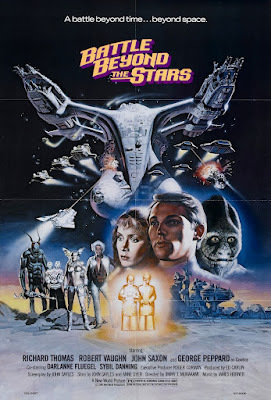
May 13, 2024
Remembering Roger Corman (who made me an author and a screenwriting maven)

The death of filmmaker RogerCorman at age 98 means that his life and career are now being subjected toserious reappraisal. Critics and film historians are busily weighing hiscontributions to the industry, focusing on his production smarts, his mentoringof many of Hollywood’s finest, and his achievements as a maverick indiedirector. How can I add to this outpouring of affection for a man who hasplayed such a large role in my own professional life?
I’ve decided to start with aslightly edited version of two personal memories that kick off my first book.It’s an independent biography now called (in its 3rd edition) RogerCorman: Blood-Sucking Vampires, Flesh-Eating Cockroaches, and Driller Killers.Here goes!
I first laid eyes on RogerCorman in 1973, when he interviewed me for a job as his assistant at New WorldPictures. He’d gotten my name through the Phi Beta Kappa chapter of UCLA, whereI was finishing up a doctorate in English. It was typical of Roger to seek outsomeone with lofty academic credentials: he loved to shore up his credibilityby hiring underlings with fancy degrees and titles.
On that first morning, I wasimpressed (as everyone always was) by Corman’s handsome face, deep voice, andgood-humored manner. We had a serious talk about motion picture aesthetics, andhe told me that one condition of my employment would be a promise to read anddiscuss with him Siegfried Kracauer’s Theoryof Film (1960). Of course I complied, wondering how this ponderous tomewould shed light on the making of Corman’s cinematic staples: monster moviesand biker flicks. I’m still wondering. He never mentioned Kracauer again.
Several jobs later, I waspersuaded by Roger to become the story editor at Concorde-New Horizons, the newcompany he had founded in 1983. My duties included overseeing writers,consulting with young directors, and earning the occasional script credit on horrorfilms and thrillers that needed emergency fixes. Life was hardly dull. OneApril afternoon in 1994, Corman called me into his office. There, dwarfed byhuge paintings that had been done on the cheap by a grad student imitatingEllsworth Kelly, we had what turned out to be another pivotal conversation.
Roger told me his fears forhis company’s financial health. (This was nothing new; he had these concernsevery week or two.) Then he brought up the plight of a close friend of mine. Asan early Corman employee, she had taughtme a great deal when I first came on board. Later, she’d moved into morelucrative positions with more prestigious film companies. But she’d hit on hardtimes, and was now desperate for work. It was a nice gesture on Corman’s partto make a place for her on his staff. It was not so nice, however, to give hermy job.
The upshot was that aftereight years of loyal service, I was rewarded with two weeks’ notice. All thewhile Roger insisted that I had been an exemplary employee. He told me to writemyself a glowing recommendation (“Don’t be modest,” he said), and promised tosign it. (And did.) I later discoveredthat in typically shrewd Corman fashion, he’d hired my old friend on a cut-ratebasis. Which meant that while lending a hand to someone in need, he wasactually saving the difference between her salary and my own. So his altruism,though undoubtedly genuine, was also to his material benefit. But such is RogerCorman: truly, the buck stops with him, in more ways than one.
Does the above implybitterness on my part? A bit. But my book also conveys the moments when Rogercould be gracious, even unexpectedly generous. Yes, he was notoriously cheap,but as he told one of my Corman colleagues who had just been handed his veryfirst directing gig, “I get the money, you get the career.” In my case, thishas meant the launch of a new life as a book author, an ongoing gig teachingscreenwriting through UCLA Extension, and some great stories to share. Thanks,Roger.
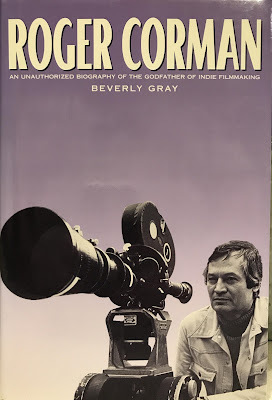 The original cover and title of my first published book
The original cover and title of my first published book
Beverly in Movieland
- Beverly Gray's profile
- 10 followers




